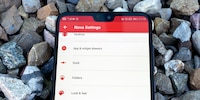
Background information
Nova Launcher: the best five francs ever invested in your phone
by Dominik Bärlocher

Google has released a new app. Tasks is small, light and, above all, very white. What is the purpose of this new app and why is it more confusing than useful?
Every time Google, the multinational that develops Android, announces something new, the world stops and has eyes only for it. Even if it's just a little app that doesn't do much. Even though Google hasn't made any publicity or announcement and has simply added the app to the App Store. I'm talking about Google Tasks, the app is curiously available for Apple devices too on iOS.
The app is simple to use, but raises quite a few questions, far too many...
Google Tasks is good for one thing: creating to-do lists. A white screen greets you when you open the app.

All interactions are positioned at the bottom of the screen. Google Tasks is made to be used with one hand.

Like many others, I prefer not to have to use both hands to use my phone. All the basic actions are made for me to navigate with just one hand.
Here are a few rules that I think all UX-UI designers should take to heart:
In practice, it looks pretty much like Google Tasks.

Some possible improvements if we want to take the concept of using the phone with one hand further:


When it comes to usability, Google pulls a bit of a string when it comes to simplicity and minimalism. There's not much you can do, because Google Tasks doesn't know how to do anything apart from create tick lists: shopping lists and to-do lists.
You can create a simple reminder by clicking the big blue button at the bottom.

You can also add a small description if you wish.

If you have a deadline for completing the task, you can also add it.

Tasks are organised as follows by default: the most recently added tasks appear at the top. The oldest tasks are therefore closest to the controls. Once there are ten or more tasks, the list is full and a scroll bar appears.
You can "Create a list" in the settings so that you don't mix up your shopping list and your notes for work. You can change the organisation of tasks in "Sort by" to arrange them by "Date".
And it's ready to go.
And that's about it. You can create tasks, edit them and you're done. Simple, fast, confusing.
It's not its complexity that makes Google Tasks confusing, but rather, the fact that the app exists in this form. I don't get it. Google already has its management app for organising tasks to improve efficiency: Google Keep for Apple iOS and for PC via the web browser.
Google Keep is powerful and also very intuitive. The only place Keep loses out is in the user interface. Tasks is much nicer and is in line with Google's latest product design, called "Material Design 2". It's rounder, shallower and whiter.
In all other areas, Tasks is a notch behind Keep. With Stéphanie Tresch, we use Tasks when we're at trade shows to sketch out a shooting schedule over breakfast. We make one Keep note a day.

We opted for this solution because Keep allows us to share lists. We can both edit and view the list. This functionality is not yet available in Tasks version 1.0.193513435. Maybe it's planned for later, maybe not. Tasks is only available locally on your phone. Deadlines don't appear in Google Calendar and you can't link a contact to a task, and they don't appear in the news feed in the Google app. Google Home doesn't know Tasks either. Tasks is in fact the only app that doesn't communicate with any other, doesn't integrate their data and doesn't allow sharing with other users.
This is certainly a positive for isolationists. Personally, I miss interoperability. Hence my question, why is the app available on iOS? Is it really necessary? What is the added value for users of Apple devices compared with the classic pen and paper? On iOS, the main advantage of Google apps lies in their synchronisation with other entities and their collaborative aspect. Tasks allows neither, so using it on iPhone makes no sense.
Finally, Tasks is a bit of a redesigned new Keep with no connectivity and is not unlike the chaos caused by Google and its messaging apps in recent years. From the outset, the firm's detractors have denounced the fact that Google has failed to provide a plausible competitor to WhatsApp, Facebook Messenger or iMessage. Critics in the US, where Internet data packages are even more limited than in Europe, are critical of the fact that there is no fallback on SMS. In other words, once the data has been used up, the messages are sent as normal text messages. With most subscriptions offering unlimited data, this isn't a problem here.
The issue of apps is more worrying. Google has already shot itself in the foot here. Repeatedly, and they seem to like it.
The app issue is more worrying.
Here's a little history of Google's messaging apps.
Currently Allo, Duo and Hangouts all run in parallel.
The question: does the same problem threaten us for task management applications?
Journalist. Author. Hacker. A storyteller searching for boundaries, secrets and taboos – putting the world to paper. Not because I can but because I can’t not.